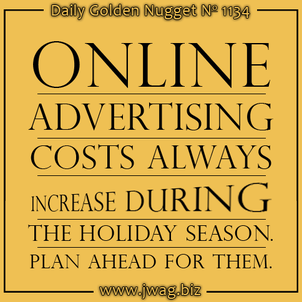
It's the Thanksgiving Holiday in the United States. For many years, this day marked the official point on the calendar as the start of the holiday season in the US. Not too long ago, you wouldn't see a single Christmas Tree or holiday decorations in a store until the Friday morning after Thanksgiving. The Macy's Thanksgiving Day parade would march down the streets of New York and not a word about Christmas was mentioned until Santa Claus went by on that last float, giving us the go-ahead to start decking the halls.
The Friday after Thanksgiving became known as Black Friday because so many people would flock to the retail store to buy gifts during that single day, bringing stores comfortably "into the black," as in their profit receipts would indicate (although that etymology is regularly challenged). To start the spending season off right, retail stores lured customers in with big sales.
The internet has changed all that. While there are still Black Friday sales, that invisible line on the calendar has blurred a lot now that customers can pre-shop for gifts online at any time. They also don't have to wait for sales now that there are plenty of websites that provide comparison price shopping all year long.
Amazon.com now makes it easy to find the same products for sale by several merchants. Just pick the lowest price, add it to your cart, and check out. All your holiday shopping is finished without worrying about holiday traffic, crazy people, or parking.
While the in-store frenzy of shopping might be subsiding, there's another type of holiday frenzy that's been steadily developing online every year over the last 10 years. It's the online advertising frenzy.
Like most advertising methods, your ad will appear in a premium location if you are willing to pay a higher price. It's the same way with online advertising through Facebook and Google.
Facebook's advertising system is designed to show you the number of people you will reach based on the amount of money you are willing to spend. If you pay attention to your ad budget between now and December 31, you'll notice that the expected reach is declining unless you increase the amount of money you are spending.
Within Google AdWords, you'll notice the cost to be on the first page of the search results is increasing.
Advertising increases like this are indicative of more people who are buying ads. Even though you might pay for online ads all year long, there are many retail companies who only pay for online ads between Thanksgiving and Christmas. Those are your competitors and they are willing to spend the extra money on advertising to help increase their website visitors and in-store foot traffic.
Unfortunately, with increased competition also comes an increased advertising cost for those premium ad locations.
I remember a few years ago I was managing an "engagement ring" AdWords campaign where the jeweler was paying $1.50 per click for first page SERP listing. By Thanksgiving that ad cost had jumped to $3 for first page placement, and then all the way up to $13 per click by mid December. Terms like "engagement rings" will bring competition from BlueNile, Kay, Tiffany, and Zales. Those are all companies with deep advertising budgets.
But it doesn't take a big budget to drive the ad costs up. It only takes a few competitors who are willing to put in an extra nickel, and then a dime, or another 50 cents every day. Before you know it, you've eaten through your entire online advertising budget before the first week of December is over.
The bottom line of today's Daily Golden Nugget is just to make you aware that online ad costs will skyrocket over the next 4 weeks, if they haven't already. Google AdWords, AdWords Remarketing, Google Shopping, Facebook Ads, and Facebook Retargeting will all be affected by the cost increase. If you want to compete this month, you need to watch your ad spending every week, preferably every day, and plan for the extra expense.
However, don't keep paying for the ads if your ROI will ultimately be zeroed out.








